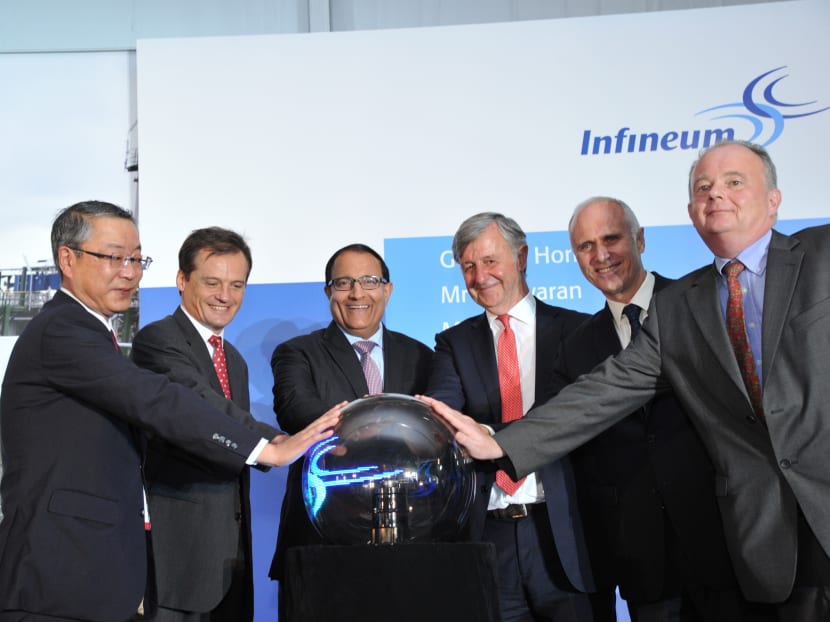Firms finalise talks to develop LPG terminal on Jurong Island
SINGAPORE — Dutch storage tank operator Vopak and South Korean energy firm SK Gas have finalised talks to jointly develop a liquefied petroleum gas (LPG) import facility on Jurong Island, which will enhance Singapore’s competitiveness and status as a top energy and chemicals hub, Second Minister for Trade and Industry S Iswaran said yesterday.

Mr Iswaran (third from left) said the new facility will allow petrochemical manufacturers here to use LPG as a feedstock to produce chemical products that are in high demand.
Photo: INFINEUM
SINGAPORE — Dutch storage tank operator Vopak and South Korean energy firm SK Gas have finalised talks to jointly develop a liquefied petroleum gas (LPG) import facility on Jurong Island, which will enhance Singapore’s competitiveness and status as a top energy and chemicals hub, Second Minister for Trade and Industry S Iswaran said yesterday.
He added that the facility will have an initial capacity of 80,000 cubic metres and will allow petrochemical manufacturers operating here to use LPG as a feedstock to produce chemical products that are in high demand.
“Energy and chemicals is a key industry cluster for Singapore, and we continue to seek ways to improve its sustainability and competitiveness …The new LPG facility will allow our crackers on Jurong Island to access LPG as an alternative feedstock to naphtha, enhancing the competitiveness of Singapore’s petrochemical industry,” Mr Iswaran said.
UOB economist Francis Tan said the development of such projects is important for Singapore to maintain its leading hub position in the energy and chemicals sector.
“We want to be the regional hub and in order to do so, we need the supporting infrastructure. Singapore’s geographic location has allowed a lot of energy trading activity to happen here, so we must not let this factor go to waste. Building more capabilities is good for us to maintain the lead and be more competitive,” Mr Tan said.
“This will also give more certainty to the (energy and chemicals) companies that have invested here. I think Singapore is moving in the right direction,” he added.
Jurong Island has attracted investments in excess of S$35 billion from the likes of ExxonMobil, Shell and Sumitomo Chemicals, contributing to the growth in the Republic’s chemicals industry. The most recent figures from the Economic Development Board’s website showed the growing importance of the industry to the overall economy, with the chemicals and chemical products sector contributing S$38 billion of the overall manufacturing output in 2010, a rise from S$28 billion in 2009.
Mr Iswaran said: “The LPG terminal (is) part of our Jurong Island version 2.0 programme, which aims to extend Jurong Island’s position as a leading global energy and chemicals hub. (This initiative) attests to the Singapore Government’s continued commitment to enhance the long-term competitiveness and sustainability of our energy and chemicals sector.”
He was speaking at the official opening of Infineum International’s new salicylate manufacturing plant on Jurong Island.
The US$150 million (S$187.4 million) facility is Infineum’s largest single largest investment to date. The decision to build a salicylate plant outside of its traditional manufacturing base in France was taken amid the growing demand in the Asia-Pacific region, said Mr Trevor Russell, the company’s executive vice-president of sales and supply.
“Infineum’s investment in this new facility is testament to our recognition of the importance of the Asia-Pacific region as a major centre of growth for our customers,” Mr Russell said.
Salicylate is a component used in the production of transportation fuels such as that for container ships. The manufacturing of such a lubricant additive is an example of a speciality chemical sector that the Government is keen to develop further as part of its efforts to strengthen the chemicals ecosystem here, Mr Iswaran said.
“We have anchored regional manufacturing facilities for the top three additives players, which collectively account for more than 80 per cent of the global market share. This places Singapore in pole position as the key manufacturing hub for lubricant additives in Asia,” he said.





